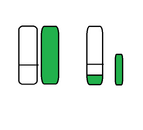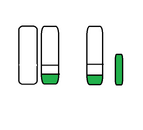Hi Dale,
Thanks for the comprehensive and friendly reply. I'll try and address your points below.
1. With a pony you have your back gas and your pony, which you reserve. With doubles you have no separate reserve, only your back gas.
So, on dive two, one dive has 100cuft + pony. and the other has 100cuft (if they used 1/2 on dive one). That reserve though, is completely dependent on one being able to isolate a failure.
Remembering also that the initial reserve is for max depth/time. On ascent one can use the reserve that becomes then unnecessary, thus a diver need not surface with the full reserve they originally conserved. I often surface with 200psi or less because I burn off the gas in the shallows.. yet I also have a pony containing max depth/time reserve.
With doubles (or a single tank for that matter) you do have a reserve. This is the minimum amount of gas required to get two divers to the surface from your maximum depth. It's called minimum gas or rock bottom and is your reserve. I think you are confusing doing a longer dive with doubles which obviously would use more gas. If one did the exact same two dives with either two single tanks or a set of doubles , one would have more gas for dive one AND two with a set of doubles. They would have all the gas for dive two + at least the left over reserve gas from dive 1.
Example:
Single 100s:
Dive 1: 100 ft^3 to start: 40 ft^3 reserve, 60 ft^3 usable gas - > return to surface with 40 ft^3 of gas (~1400PSI left in tank 1)
Dive 2: new tank, 100 ft^3 to start: 40 ft^3 reserve, 60 ft^3 usable gas - > return to surface with 40 ft^3 of gas (~1400PSI left in tank 2)
Twin 2x 100ft^3 doubles
Dive 1: 200 ft^3 to start: 40 ft^3 reserve, 60 ft^3 usable gas - > return to surface with 140 ft^3 of gas (~2500 PSI left in doubles)
Dive 2: 140 ft^3 to start: = You have much more gas than with the single tanks on BOTH dives
I hope that example clarifies it for you. If you want to add a static pony to the single tank example it won't change the outcome...unless the pony is actually an AL80

..in which case I'd be hard pressed to call it a pony

2. That is planning for two failures, which nobody does for practical reasons. What happens if you are using doubles and your buddy goes OOA, you donate your octo and then also go OOA - same thing.
I agree, planning for two failures can lead to all sorts of extra precautions. For instance cave divers will take three lights with them at a minimum but that's a special scenario. The scenario I gave you is actual only one failure though. In risk mitigation speak it's referred to as the "incident pit" where poor/improper planning before the dive and one failure during the dive leads to an exponentially worse situation. like a snowball rolling down a hill if I could use an analogy.
3. Proper gas management does not provide a second air source. Some divers are solo divers, others experience buddy seperation because of conditions and others are just tired of placing their safety in the hands of unknown insta buddies. It is odd to me that people are comfortable going below CESA depth without a RAS considering we cannot yet breath water. Placing your life in the hands of another seems secondary to taking control of your own safety by carrying a RAS.
Proper gas planning does provide a second air source. It's your buddy and he/she has a reserve (to get both of you to the surface, not just one) for you as well. If everyone practiced it there would be no issues. I've had some harrowing experiences with insta-buddies and know what you mean. I prefer to dive with those that can do proper gas management so I don't have to come up with a silly and complicated solution to a very easy way to solve a problem : proper gas management
4. My mistake. You would need to add weight or accept being very negative at the beginning. As for being over weight, there was a recent death of a popular member, Quero, that outlines the dangers of this. Many divers do use a DS as a second BCD. But others dive wet. And those that dive wet with doubles either use Al80's or redundant bladders. The reasons for this has been discussed in detail in DIR circles.
No need to add weight, in fact weighting should always stay constant between dives using doubles. You will actually have less "lead" weight on your belt if using steel doubles as the extra steel tank is usually (well most are) -ve buoyant when empty. The best bang for the buck in terms of size of tank to total weight carried for a given amount of gas seems to lie with the steel 100s. Yes, diving thick wetsuits and steel double tanks is not a good idea, it's downright dangerous. I could show you some math that shows why. Essentially the wetsuit compresses and becomes less buoyant at depth and if you have a wing failure you won't be able to ditch enough weight to swim up.
5. Your initial question was: "I'm confused. Why does one even need a pony bottle?"
No one said it was better or worse. It's just a very awkward solution for many situations in which a RAS might be considered. I use doubles sometimes myself, as one of several options for redundant air.
I agree it's an awkward and cumbersome solution when proper gas planning/management will fix most all the issues. Looks like we agree on something

---------- Post added July 17th, 2014 at 08:14 AM ----------
The point was you sling a bottle on dive two with doubles and I sling a bottle with a single. The semantic argument is more for beginners I believe who need general rules of thumb to stay safe (always surface with 500psi). Once you get how to optimize your gas, what you call the bottle becomes a somewhat mute point.
Ya, I didn't bother with semantics. I know what you were talking about. However, I think just telling beginners to surface with 500 PSI is a disservice and dangerous. They don't start off with the mindset of what that 500 PSI is for. Furthermore, ask a beginner to tell you how much gas they need to get to the surface sharing gas with a buddy from the maximum deopth and you will get a deer in the headlights blank stare....it's just not taught. Then you get suggestions to just add a pony bottle for RAS when they still don't know how much they need or how to plan gas correctly. It just perpetuates the problem. Learn proper gas management please people







